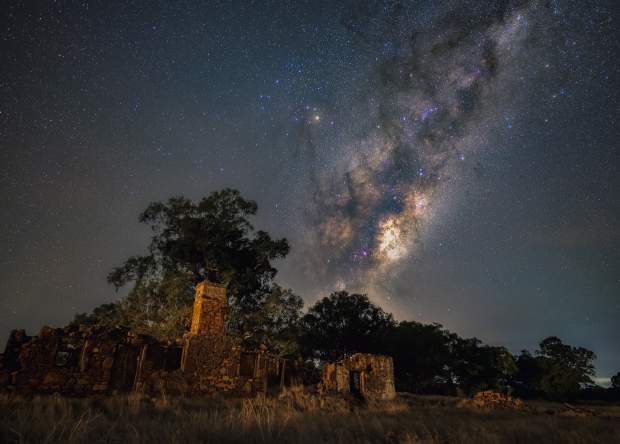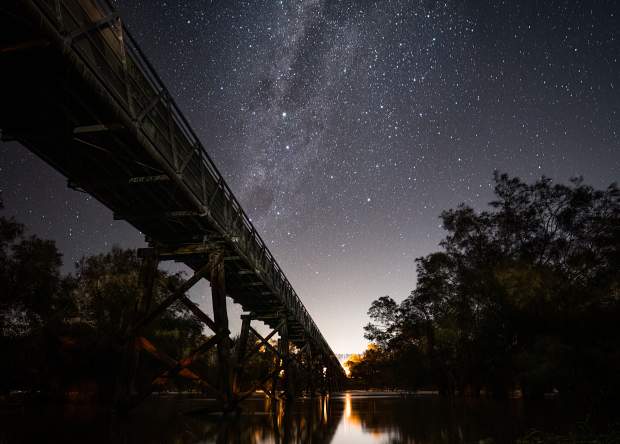Psst! We’ve made the best list in the whole universe. We’re back in 2024 with a new guide to stargazing in Western Australia.
With help from our friends at Astrotourism WA, we’ve created a month-by-month breakdown of the ultimate events and places to discover WA’s best stars.
It’s time to venture beyond the fringe of the city lights and celebrate WA’s world-class dark night sky. Each month brings billions of stars and planets with incredible stargazing experiences around every corner.
Let’s see what’s up in 2024.
January: Go Galaxy Hunting
Did you know we have about 50 galaxies in our local Milky Way galactic neighbourhood? Two of these, the Magellanic Clouds, are our close neighbouring galaxies that can be seen with the naked eye without a telescope or binoculars. All you need is a location with a very dark night sky with no moonlight.
We’ve checked the lunar calendar for this year and here are the best times to see the Magellanic Clouds.

February: Hunting with Orion
Orion the Hunter is a well-known summer constellation, and it is up in the early evening for you to see. Head outside and look directly to the east. The brightest star you’ll see is Sirius. Directly to the left of Sirius is what is often referred to as ‘the Saucepan’, which is part of the Orion constellation. Three bright stars in a reasonably straight line make up the base of the saucepan – this is Orion’s belt. Three more stars that angle out to the top right form the handle, Orion’s sword.
March: The Seven Sisters Dazzle
Our top pick this month is a beautiful pairing in the early autumn night sky. On 15th March the crescent moon will appear close to the Pleiades star cluster below the constellation of Taurus in the north-western sky after dark. Pleiades is an important astronomical object within Aboriginal culture.
You’ll need a lovely dark night for good views. See how many stars you can count in the Pleiades star cluster when you’re in and around Northam. You might even try your hand at some photographing the night sky above historic ruins like Glenfield Homestead. It’s on the picturesque Katrine Road west of Northam. There’s a pull over bay where you can park and set up for astrophotography.
April: Milky Way Galaxy
April to October is Milky Way season. The Milky Way is best seen when there’s no moonlight, and you’re away from bright city lights. This band of dusty light looks like a cloud, but billions of stars make up the Milky Way galaxy, our home in the universe.
Where can you see the Milky Way? Travel to an Astrotourism Town on a moonless night and be inspired by its beauty. From the coastal town of Cervantes to inland Northam - local communities are creating protected dark sky places across country and outback WA where the stargazing is spectacular. Check out some of the best country locations for stargazing.

May: Eta Aquarids
The Eta Aquarid meteor shower 2024 is active between April 15 and May 27 and peaks on the night of May 4 and predawn hours of May 5. The peak of the Eta Aquarids is around the time of the new moon, therefore moonlight will provide minimal interference to meteor hunters!
June: Aboriginal Astronomy
Aboriginal people are the world’s first astronomers. Tens of thousands of years of culture and heritage are reflected in WA’s night sky. The Emu in the Sky is a well-known Aboriginal Astronomical constellation outlined by dark areas of the night sky, not the stars.
To discover the emu, locate the Southern Cross constellation in mid-June. The emu’s head is the dark between the stars that make up the Southern Cross. From here, you can see its neck, body, and legs forming between the Milky Way's iconic dust lanes.
Discover more about the Aboriginal connection to the night sky and how it connects to their beliefs and culture at the Bilya Koort Boodja: Centre for Nyoongar Culture & Environmental Knowledge in Northam.
July: Meteors in the Sky
The Southern delta-Aquarids Meteor Shower occurs at a good time to try and spot some meteors (or “shooting stars”). There’s no moonlight at the time of the meteor shower’s peak which makes it easier to see more meteors as they burn up in Earth’s atmosphere. How many can you count?
The Southern Delta-Aquarids Meteor Shower is hitting the sky in July. Best viewing is early in the morning on 31st July. You’ll need a dark sky location and a great place in Perth hinterlands is Spoonbill Lake south of Bindoon in Chittering. Make sure you have your coat, beanie, scarf and your favourite hot drink in a thermos!

August: Sagittarius and a Teapot!
You may have heard about “the saucepan in the sky”. That’s part of the constellation of Orion. Did you know there’s also the shape of teapot in the sky? See if you can find the teapot in Sagittarius…
And another thing… when we look towards the constellation of Sagittarius, we are looking towards the heart of our Milky Way Galaxy! Check out the heart of our galaxy when you’re next in an Astrotourism Town, roll out your favourite picnic rug and start counting shooting stars.
September: Watch as a Star Disappears Behind the Moon!
On the 10th September, watch this amazing event happen before your very eyes! The Moon will pass in front of the bright red star of Antares. It’s called a lunar occultation. You’ll see it with the naked eye but see if you can borrow a pair of binoculars for a closer look. What time do I look?
October: The Supermoon Rises!
Watching a Supermoon rising is getting more and more popular each year. On 17th October, choose a favourite location in or around Perth where you can see clearly to the eastern horizon and you’re all set for a great evening out. What is a Supermoon and when does it rise?

November: Andromeda
Andromeda is in our galactic neighbourhood of local galaxies. It’s 2.5 million light years away and they say it is the most distant object visible to the human eye! Head out to an Astrotourism Town on a moonless weekend and try your luck. Will you be able to see Andromeda?
If you’re looking for wonderful itinerary ideas to find dark night skies, you can’t go past Perth’s Top Stargazing Trails!
December: Christmas Eve Planet Spectacular
Which are the two brightest planets we can see from Earth in our night sky? Venus and Jupiter! On Christmas eve, head outside at 8pm. The two planets will be on opposite sides of the sky to one another. These are the brightest of lights on a Christmas eventing. Do you wonder if there is an astronomical explanation for the Star of Bethlehem? Maybe there is…
Get the most out of your stargazing experience with our guide to Stargazing In Perth. It’s full of bright tours and astronomy hotspots that offer stargazing experiences that are literally out of this world.

